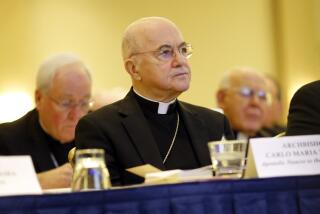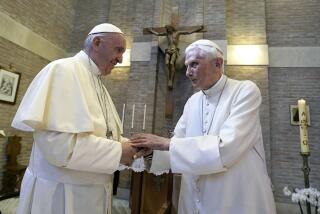Pope’s September surprise
- Share via
POPE JOHN XXIII, or “Good Pope John,” remains one of the most beloved figures in recent Catholic history. Among treasured memories of this kindly, roly-poly pope, perhaps none looms larger than the evening of Oct. 11, 1962, when he told a vast crowd on a moonlit night in St. Peter’s Square, “Go home tonight and give your children a kiss, and tell them that this kiss comes from the pope.” When German Cardinal Joseph Ratzinger, the Vatican’s stern doctrinal enforcer, was elected as Benedict XVI in April, an editorial cartoon in an Italian paper showed him looking at a similar crowd and saying, “Go home tonight and give your children a spanking, and tell them that this spanking comes from the pope.”
In a nutshell, the cartoon captured many people’s expectations of Benedict XVI: a hard-line taskmaster who would bring liberals and dissenters in Roman Catholicism to heel.
For some, those expectations found early confirmation on Aug. 29, when Benedict XVI granted a private audience to Bernard Fellay, a Swiss Catholic clergyman illicitly ordained a bishop in 1988 by Archbishop Marcel Lefebvre, an intransigent French traditionalist who founded the breakaway Society of St. Pius X after Vatican II. Lefebvre and his followers were outraged by the Catholic Church’s transition away from Mass in Latin, as well as its embrace of inter-faith dialogue and religious liberty.
The group went into formal schism from the Vatican in 1988 when Lefebvre ordained four priests, including Fellay, as bishops without the approval of Pope John Paul II.
Today, Fellay is the head of Lefebvre’s movement, and many Catholics saw the August encounter at Castel Gandolfo, the pope’s summer residence, as a signal that Benedict XVI wants to steer the Catholic Church closer to the views of this far-right splinter group.
That reading held up until Sept. 24, when something many Catholics would have regarded as almost unthinkable happened: Pope Benedict granted another private audience to another Swiss clergyman -- but this time it was the poster child for liberal Catholic dissent, famed theologian Hans Kung, who had petitioned John Paul II for a meeting since the late 1970s without success.
Kung and the new pope met at Castel Gandolfo for four hours, stretching over dinner and beer.
They did not talk about issues on which they disagree, such as papal infallibility or birth control. Instead, they talked about Kung’s effort to develop a common set of ethical principles among the world religions in order to mount a moral challenge to globalization. Benedict affirmed and encouraged Kung in his work.
At one level, this was a reunion of two old friends. Kung got then-Father Joseph Ratzinger a job at the University of Tubingen in Germany in the mid-1960s, and these two young Turks of the Catholic theological world had a standing weekly dinner date. Their later falling out, as Ratzinger became a bishop and cardinal while Kung lost his license to teach Catholic theology, was painful on both sides.
On another level, the meeting with Kung had clear symbolic significance for the broader church. It was, in effect, Benedict’s way of saying that he wants to be pope not just of a faction of the Catholic Church but of the whole 1.1 billion family of faith, including its liberal wing.
He may not be willing to budge on matters of doctrine, but he’s willing to talk about almost anything else.
Pope Benedict was the right-hand man of John Paul II for almost 25 years, and he loves and admires his predecessor. Yet he also saw the weaknesses of the pontificate from within, one of which was John Paul’s odd incapacity to foster the same dialogue inside the Catholic Church that he pioneered on the global stage. This was a pope who could talk to Muslims, to Jews, to nonbelievers, to the worlds of science and industry and art, yet never opened a similar conversation with the dissidents in his own ranks. The result was not merely disagreement in the church but a sense of alienation in more liberal quarters.
Having taught theology at rebellious, secular German universities in the 1960s and 1970s, Ratzinger learned the hard way how to talk to Catholics with different ideas. As a German Catholic, he also understands that there are plenty of good, faithful Catholics out there who sometimes chafe at Roman authority. As a result, this “hawk” may actually turn out to be the pope of dialogue ad intra, meaning inside the church, that John Paul II never could be.
Looking at the sessions with Fellay and with Kung, many observers may naturally be puzzled. Is the new pope going to turn out to be “God’s Rottweiler” or “Good Pope Benedict”?
The best answer so far seems to be “both.”
More to Read
Sign up for Essential California
The most important California stories and recommendations in your inbox every morning.
You may occasionally receive promotional content from the Los Angeles Times.










